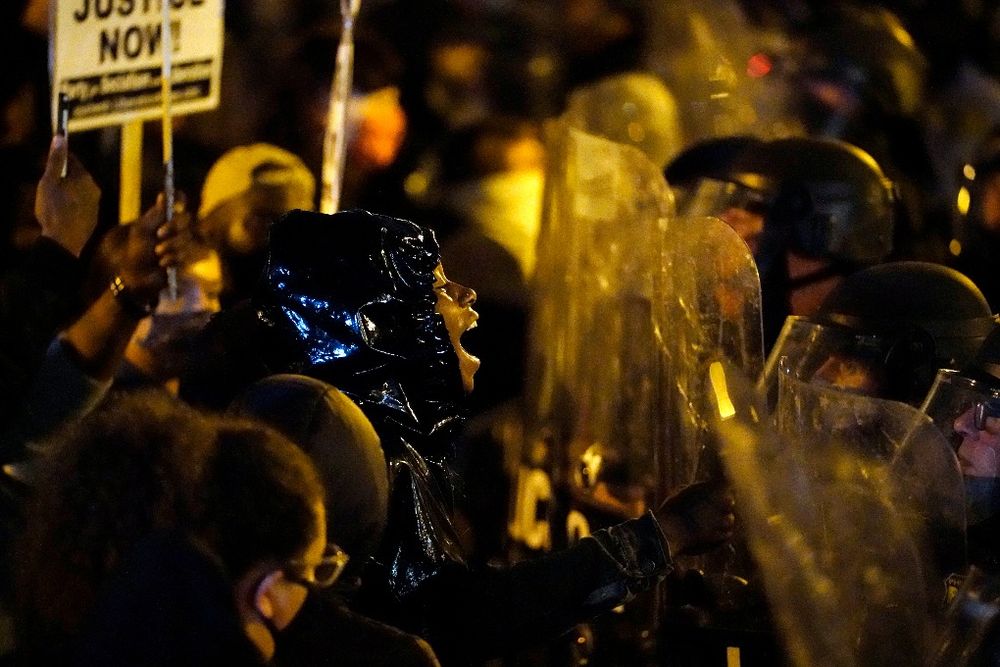As of the 21st, the cumulative number of confirmed cases of COVID-19 in the United States exceeded 12 million, and the cumulative number of deaths exceeded 255,000. However, this divided country is still still united.” In the face of this shocking number, The New York Times sighed so much.
Against the backdrop of the election year, American society is surrounded by many contradictions: ethnic conflict, political polarization, social unrest u2026u2026, and the coronavirus response is out of control, which reflects an increasingly torn and chaotic America.
Deeply uneasy
Shops have closed doors and windows with wooden boards, polling station demonstrations continue, gun sales have increased significantly, residents are panicked. Before and after the voting day of the U.S. election, demonstrations broke out in many parts of the United States. Groups from different political positions took to the streets to vent their dissatisfaction and even turned violent conflict.

On November 2, merchants in the Beverly Hills business district of Los Angeles County, United States, sealed the doors and windows of the store. In response to possible protests or riots in the U.S. election, many commercial districts in Beverly Hills have begun to strengthen protection and security.
The U.S. media pointed out that these boards in shops along the street are reminding Americans of “how bad the reality is” and that “this election has increased people’s fear and unease”.
Since the beginning of this year, the impact of the coronavirus epidemic, the United States has suffered from the economic recession, high unemployment, intensified ethnic antagonism, and large-scale protests have taken place throughout the United States. Many businesses have not returned to normal. In recent days, several universities in Washington, New York, Chicago and other places have warned students to prepare for possible ongoing social unrest and hoard the necessary materials “like a hurricane or a snowstorm”.
The Washington Post article said that the damage caused by American retailers due to property damage and theft this year has been estimated to have reached $1 billion, and this year’s protests have become “the most costly riot in American history”.
The New York Times noted that this is a country with nearly 8% unemployment, more than 200,000 people have died from COVID-19, and four in five people are worried about the future.” Differences and anxiety are obvious.
Deep tear
The website of The Economist recently published a cartoon: During the voting in the U.S. election, supporters of both the Republican and Democratic camps were deeply anxious, biting their nails on one side and pulling their hair on the other. The illustration said: “This election has deeply divided the Americans.”
Philadelphia, Pennsylvania’s largest city, triggered a public protest after a police shot and killed a black man in the early morning of October 26th. Police clashed with demonstrators, injuring about 30 policemen and dozens of people arrested.
Michael Dimock, chairman of the Pew Research Center in the United States, wrote that Americans are rarely as polarized as today. Studies over the past few years have shown that Republicans and Democrats are increasingly divided on a long list of issues such as economic policy, racial contradictions, climate change, etc. A poll released by the center recently also shows that the deep differences between supporters of the two parties are not limited to politics and policies, but also tearing apart at the value level.
In recent years, this dichotomy of winning or losing, “support me” or “again me” has always dominated American politics in recent years.
“The polarization has taken over every aspect of American life and is affecting families, friendships, love, marriage, communities, the workplace, schools, and even the medical fields,” said Stephen Stasis, a history expert at the Congressional Research Service at the Library of Congress.
Deep defects
Behind the deep tearing of American society are many contradictions such as the widening gap between rich and poor, prominent inequality and injustice, deep-rooted systemic racial discrimination, and the pervasive extreme emotions based on identity. Under the impact of the COVID-19 epidemic, these “dislocations” are more serious, and the rifts in the regional, social, racial, gender and other aspects are deepening.

Pedestrians walk in New York Times Square on November 18.
According to the Federal Reserve’s estimates, the richest 10% of households in the United States hold 70% of the total wealth of the United States, up 10 percentage points from the 1980s. The difference between races is also alarming. Whites own 84% of the wealth of the United States, while blacks own only 4.1%.
Under the deliberate instigation of political polarization, policy populism and deliberate incitement by politicians, the tearing of American society is getting worse and worse, and racial and class antagonism is serious. The French weekly Express website said: “The atmosphere in the United States is like a powder keg.” The trust of the American public in the government is at an all-time low. A poll in September showed that only 20% of American adults believe that the government will “do the right thing”.
Richard Haas, president of the American Institute of Foreign Affairs, recently wrote that the existing system of the United States is seriously flawed. Everyone recognizes this, but cannot reach a consensus on reform. Today, the United States is in a situation that can be called “one country, two peoples”.



